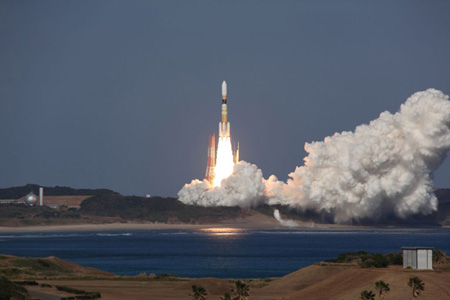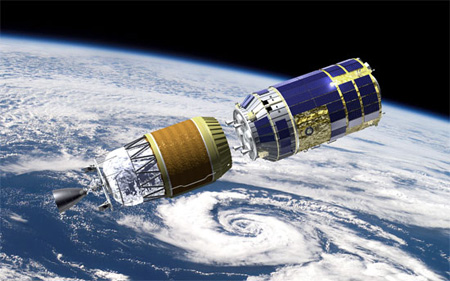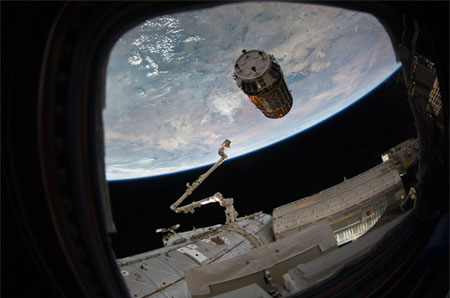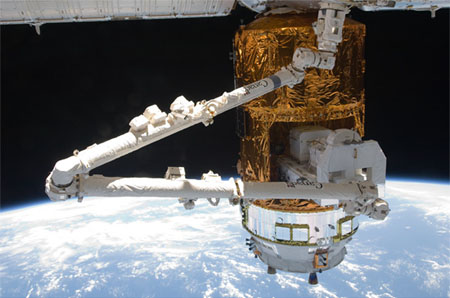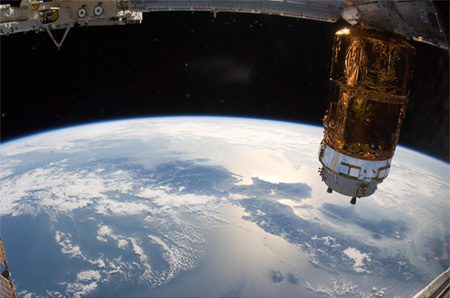.







Launch Postponement of H-IIB Launch Vehicle No. 6
with H-II Transfer Vehicle “KOUNOTORI6” (HTV6) Onboard
August 10, 2016 (JST)
Mitsubishi Heavy Industries, Ltd.
National Research and Development Agency
Japan Aerospace Exploration Agency (JAXA)
Mitsubishi Heavy Industries, Ltd. and the Japan Aerospace Exploration Agency (JAXA) decided to postpone the launch of the H-IIB Launch Vehicle No. 6 with the H-II Transfer Vehicle “KOUNOTORI6” (HTV6) onboard from the Tanegashima Space Center, which was scheduled for October 1 (Sat.), 2016 (Japan Standard Time), as unfavorable.
The new launch date will be announced as soon as it is determined.
(Reason for the delay)
A slight leak was detected from piping of the HTV6 during an air tightness test. The test is part of HTV6 launch preparations at the launch site. We will disband the HTV6 module and take necessary measures.
Quelle: JAXA
-
Update: 7.10.2016
-
Launch of the H-II Transfer Vehicle "KOUNOTORI6" (HTV6)
aboard the H-IIB Launch Vehicle No. 6
October 7, 2016 (JST)
Mitsubishi Heavy Industries, Ltd.
National Research and Development Agency
Japan Aerospace Exploration Agency (JAXA)
Mitsubishi Heavy Industries, Ltd. and JAXA postponed the launch of the H-IIB Launch Vehicle No. 6 with "KOUNOTORI6" (HTV6, a cargo transporter to the International Space Station) on board which was previously scheduled for October 1 (Sat.), 2016 (Japan Standard Time).The updated launch schedule is as follows:
| Scheduled date of the launch: | December 9 (Friday), 2016 (Japan Standard Time, JST) |
|---|---|
| Launch time: | around 10:26 p.m. (JST) *1 |
| Launch windows: | Dec 10 ( Sat.) through Dec 31 ( Sat.), 2016 *2 |
| Launch Site: | Yoshinobu Launch Complex at the Tanegashima Space Center |
(*1) Time will be determined by the updated orbit of the International Space Station (ISS).
(*2) The launch day and time during the launch windows shall be decided by the international coordination for ISS operations.
Quelle: JAXA
-
Update: 1.11.2016
-
ISS batteries loaded into KOUNOTORI6
From June 1-2, the operations for loading the ISS battery Orbital Replacement Units (ORUs) into the H-II Transfer Vehicle KOUNOTORI6 and filling the water bags were unveiled to the press at the Tanegashima Space Center (TNSC).
On the ISS, the batteries are charged with electricity generated by the solar panels and used when the ISS travels through shadow areas. Sets of nickel metal-hydride batteries made in the U.S. were used on the ISS, but given the approaching end of their service life, a new type of Japanese lithium-ion battery was adopted as the replacement.
Sets of new batteries that KOUNOTORI6 delivers are manufactured by GS Yuasa Technology Ltd, and feature a service life lasting nearly 10 years. Although 48 battery ORUs are currently used on the ISS, the new battery ORUs can provide enough power with only 24 battery ORUs.
KOUNOTORI6 will deliver six battery ORUs (each weigh 250 kg) this time, with the rest to be delivered aboard KOUNOTORI7-9. Currently, only the HTV can deliver a large number of ISS battery ORUs.
Unveiling to the press included the introduction of water-filling equipment that transfers potable water to fill the water bags (Contingency Water Container Iodine: CWC-I) for delivery to the ISS.
This water-filling equipment was also used to fill a total of 600 liters of Tanegashima island water in 30 dedicated water bags that were loaded into the Pressurized Logistics Carrier (PLC) of KOUNOTORI6.
Through the delivery of batteries and water by the HTV missions, Japanese space development activities serve as the backbone of ISS operations.
---
KOUNOTORI6 (HTV6) Makes Debut to Media

|
On October 19, members of the media were invited to view KOUNOTORI6 (HTV6), H-II transfer vehicle to the Space Station. The event was held at Tanegashima Space Center (TNSC) and attracted many as it showed actual HTV6 before launch. |

Quelle: JAXA
.
Update: 6.11.2016
.
| Item | Description | |
|---|---|---|
| HTV Flight Name | HTV6 (KOUNOTORI6) | |
| Launch date and time | 10:26 p.m.*1, December 9 (Friday), 2016 | |
| Launch window | December 10 - 31, 2016, 2016*2 | |
| Launch site | Yoshinobu Launch Complex, Tanegashima Space Center (TNSC) | |
*1: Time will be determined by the updated orbit of the International Space Station (ISS).
*2: The launch day and time during the launch window shall be decided by the international coordination for ISS operations.



HTV Operations
The profile for the HTV operations is as follows.
- Launch
- Rendezvous with the International Space Station (ISS)
- Berthing with the ISS
- Operations while berthed with the ISS
- Undock/Departure from the ISS / Reentry
Launch
The HTV will be launched from the Tanegashima Space Center aboard an H-IIB launch vehicle.
After separating from the H-IIB launch vehicle, the HTV will automatically start-up the HTV subsystems and initiate communications with the HTV Mission Control Room (HTVMCR) at Tsukuba Space Center (TKSC).
Rendezvous
After separating from the H-IIB launch vehicle, the HTV will approach the ISS in the sequence described below.
- After separating from the H-IIB launch vehicle, the HTV will automatically start-up the communication system and initiate communications with NASA's Tracking and Data Relay Satellite (TDRS).
- The HTV status will be monitored from the HTVMCR at TKSC. It will take about three days for the HTV to reach close proximity to the ISS.
- When the HTV reaches the "proximity communication zone" (23km from the ISS), the HTV will then be able to directly communicate with the ISS.
- The HTV will establish communications with the Proximity Communication System (PROX).
- While communicating with PROX, the HTV will approach the ISS guided by GPS signals until the HTV is 5km behind the ISS. At this point, the HTV will maintain this distance from the ISS.
Berthing with the ISS (Berthing Phase)
The HTV will slowly approach from the nadir (bottom) side of the ISS (from the direction of Earth). The HTV will then be grappled by Canadarm2 and berthed with the ISS. This phase is called the "Berthing Phase."
The HTV's approach in the Berthing Phase is as follows.
- Guided by GPS signals, the HTV will approach to within 500 meters below the ISS.
- While using the Rendezvous Sensor (RVS), the HTV will move closer to the ISS guided by the reflectors that are installed on Kibo.
- At this point, the HTV will maintain a distance of 10 meters below the ISS.
The HTV approach speed during this phase is 1 to 10 meters /minute. During the approach, the ISS crew can send commands such as "HOLD," "RETREAT" or "ABORT" to the HTV.
Once the HTV is within a certain distance from the ISS, the HTV thrusters will be disabled. Next, the HTV is grappled by Canadarm2 and berthed to the nadir (bottom) side of "Harmony" (Node 2), through Harmony's Common Berthing Mechanism (CBM).
Operations while berthed to the ISS
While the HTV is berthed to the ISS, both the HTV and ISS hatches will be opened. The ISS crew will then transfer the supplies (ISPRs, drinking water, clothes, etc.) from the HTV Pressurized Logistics Carrier (HTV-PLC) to the ISS. After the supplies are transferred, the HTV will be loaded with waste from the ISS.
Next, the ISS crew will unload the Exposed Pallet from the HTV Unpressurized Logistics Carrier and attach it to the ISS Mobile Base System or Kibo's Exposed Facility using the Canadarm2.
Departure from the ISS and Reentry
After being loaded with waste, the HTV will undock and separate from the ISS and then be destroyed during reentry into the atmosphere. The HTV debris is expected to fall within the South Pacific Ocean. However, the Indian Ocean is also planned as a backup area.

HTV3's reentry taken by the onboard i-Ball camera (Credit: JAXA/IHI Aerospace)

HTV4's reentry taken from the ISS (Credit: JAXA/NASA)
Quelle: JAXA
-
Update: 21.11.2016
.

Quelle: JAXA
-
Update: 25.11.2016

Quelle: JAXA
-
Update: 5.12.2016

Quelle: JAXA
-
Update: 6.12.2016
.
The launch of a Japanese cargo ship to the International Space Station, and its arrival at the orbiting laboratory, will be broadcast Dec. 9 and 13 on NASA Television and the agency’s website.
The Japan Aerospace Exploration Agency (JAXA) is scheduled to launch its H-II Transfer Vehicle (HTV)-6 at 8:26 a.m. EST (10:26 p.m. Japan time) Friday, Dec. 9, from the Tanegashima Space Center in southern Japan. NASA TV coverage of the launch will begin at 8 a.m.
Loaded with more than 4.5 tons of supplies, water, spare parts and experiment hardware for the six-person station crew, the unpiloted cargo spacecraft, named “Kounotori” – the Japanese word for white stork – will set sail on a four-day flight to the station. Also aboard the resupply vehicle are six new lithium-ion batteries and adapter plates that will replace the nickel-hydrogen batteries currently used on the station to store electrical energy generated by the station’s solar arrays. These will be installed during a series of spacewalks currently scheduled in January.
On Tuesday, Dec. 13, the HTV-6 will approach the station from below, and slowly inch its way toward the complex. Expedition 50 Commander Shane Kimbrough of NASA and Flight Engineer Thomas Pesquet of ESA (European Space Agency) will operate the station’s Canadarm2 robotic arm from the station’s cupola to reach out and grapple the 12-ton spacecraft and install it on the Earth-facing side of the Harmony module, where it will spend more than five weeks. Flight Engineer Peggy Whitson of NASA will monitor HTV-6 systems during the rendezvous and grapple.
NASA TV coverage of the Dec. 13 rendezvous and grapple will begin at 4:30 a.m. Capture of the spacecraft is scheduled around 6 a.m. Coverage of the final installation to Harmony will resume at 9:15 a.m.
Quelle: NASA
-
Update: 9.12.2016
.
JAXA and ISS Program prepare for HTV-6 resupply launch to Station

In what is slated to be the fifth orbital launch of December out of a whopping 13 planned (15 possible) orbital missions, the Japanese Aerospace Exploration Agency (JAXA) is preparing to launch the HTV-6 automated resupply spacecraft for the International Space Station atop their H-IIB rocket. Liftoff from the Tanegashima Space Center is set for 22:26:47 Japan Standard Time (13:26:47 GMT – 08:26:47 EST) on 9 December, kicking off a four-day rendezvous dance with the ISS.
HTV-6 overview:
HTV-6 (H-II Transfer Vehicle 6) is the sixth craft in a fleet of one-time use uncrewed resupply vehicles that serve JAXA’s commitments to the International Space Station (ISS).

Unlike Orbital ATK’s Cygnus and ESA’s ATV (Automated Transfer Vehicle) resupply vehicles which receive (or received, in ATV’s case) individualized names for each mission, every HTV carries the same name: Kounotori, meaning white stork.
As with its HTV predecessors, HTV-6 is comprised of four main components – a Pressurized Logistics Carrier (PLC); Unpressurized Logistics Carrier (UPLC), inside of which is an Exposed Pallet (EP) onto which external cargo is mounted; an Avionics Module; and a Propulsion Module.
Generically, the PLCs can accommodate up to eight International Standard Payload Racks (ISPRs) for ISS internal cargo while the large UPLC makes HTV one of only two resupply vehicles (the other being SpaceX’s Dragon) capable of delivering external supplies to the ISS.
The Avionics Module contains all of the power and command & control systems while the Propulsion Module houses all of the propellant tanks and main orbital adjustment engines – including both 500 N class HBT-5 thrusters and 120 N class HBT-1 thrusters.
Moreover, HTV-6 will debut five new updates and upgrades from its immediate predecessor, HTV-5.
The major alterations for HTV-6 include the removal of one solar cell panel, bringing the total to 48; the elimination of one primary battery, bringing the total to 6; the removal of navigation/position lights that face Earth during ISS approach operations; the introduction of a strengthened EP to hold a maximum of 1.9 t, up from 1.6 t; and the inclusion of built-in payloads for technology demonstrations.
Specifically, HTV-6 will carry two technology demonstrations, SFINKS (Solar Cell Film Array Sheet for Next Generation on Kounotori Six) and KITE (Kounotori Integrated Tether Experiment).
SFINKS will test thin film solar cells while KITE will test an experimental electrodynamic tether – which will eventually aid space debris removal efforts.
HTV-6 mission:
HTV-6, delayed from September 2016 due to leaking pipes, is set to launch atop the Japanese H-IIB rocket – developed exclusively for HTV – from the Yoshinobu Launch Complex at the Tanegashima Space Center in Southern Japan at 22:26:47 local time (13:26:47 GMT – 08:26:47 EST) on Friday, 9 December 2016.
 Just prior to liftoff, the H-IIB core stage’s two LE-7A engines will ignite and ramp up to full thrust – a combined 494,000 lbf.
Just prior to liftoff, the H-IIB core stage’s two LE-7A engines will ignite and ramp up to full thrust – a combined 494,000 lbf.
At liftoff, the four strap-on A3 Solid Rocket Boosters (SRBs) will ignite, providing a combined 2,070,000 lbf of thrust for a total liftoff thrust of 2.564 million lbf.
Each of the four A3 SRBs weighs 76,500 kg (168,654 lb) and carries a total of 65,950 kg (145,395 lb) of HTPB propellant.
The four A3 SRBs burn for a total of 114 seconds (1 minute 54 seconds) before they burn out and separate.
The first stage, which thrusts continuously through SRB flight, burns a mixture of LH2 and LOX, carries a total of 177,800 kg (391,982 lb) of propellant and burns for 352 seconds (5 minutes 52 seconds).
 After first stage shutdown and separation, the second stage’s single LE-5B engine ignites, producing 31,000 lbf of thrust – from 16,600 kg (36,597 lb) of LOX and LH2 – for 499 seconds (8 minutes 19 seconds).
After first stage shutdown and separation, the second stage’s single LE-5B engine ignites, producing 31,000 lbf of thrust – from 16,600 kg (36,597 lb) of LOX and LH2 – for 499 seconds (8 minutes 19 seconds).
Following a 14 minute 11 second ride to orbit, the H-IIB booster will place HTV-6 into an initial orbit of 200 x 300 km, inclined at 51.6 degrees to the equator.
HTV-6 controllers will then spend the next four days conducting a series of rendezvous burns to raise HTV-6’s altitude to around 405 km, the height of the ISS, in order to put the craft in the correct position to rendezvous with the Station at 09:30 GMT (04:30 EST) on Tuesday, 13 December.
HTV-6 Payload Complement:
While upcoming resupply missions in January and February 2017 might see their payload complement adjusted following last week’s loss of the Progress MS-04/65P vehicle, HTV-6’s payload is unaffected, with NASA public affairs noting to NASASpaceflight.com that “There were no items added to the HTV-6 manifest following the anomaly with ISS Progress 65.”
 In total, HTV-6 is packed with 2,566.25 kg (5,657.6 lb) of internal cargo – with an additional 186 kg (410 lb) of packaging for that payload.
In total, HTV-6 is packed with 2,566.25 kg (5,657.6 lb) of internal cargo – with an additional 186 kg (410 lb) of packaging for that payload.
Among these pressurized cargo items include 156 kg (344 lb) of computer resources, 35 kg (77 lb) of EVA (Extra-Vehicular Activity) supplies, and 663 kg (1,461 lb) of vehicle hardware and spare parts (including a new Carbon Dioxide Removal Assembly – CDRA – bed).
Additionally, 420 kg (926 lb) of utilization and science experiment/hardware – including a Two-Phase Flow experiment unit, a Position-Sensitive Tissue Equivalent Proportional Chamber radiation measurement instrument, the Exposed Experiment Handrail Attachment Mechanism, an HDTV-EF2 hi-def and 4K camera, a new JEM Small Satellite Orbital Deployer – is also riding to orbit aboard HTV-6.
Moreover, the craft is carrying 28.25 kg (62.28 lb) of hardware for the Russian segment of the Station.
 Importantly for the Expedition 50 crew, HTV-6 is carrying 1,264 kg (2,786.6 lb) of food, water (600 liters), clothing, and various other items for crew health and daily activity.
Importantly for the Expedition 50 crew, HTV-6 is carrying 1,264 kg (2,786.6 lb) of food, water (600 liters), clothing, and various other items for crew health and daily activity.
Additionally, HTV-6 is also tasked with delivering 1,367 kg (3,014 lb) of external cargo – Lithium Ion batteries and adapter plates – in the UPLC.
The six new batteries will replace 12 aging Ni-H (nickel-hydrogen) batteries.
At the end of its planned 60-day mission at ISS, HTV-6 will be packed with nine of the 12 Ni-H batteries and will dispose of them during its destructive End Of Mission plunge into the atmosphere.
The three remaining Ni-H batteries will remain on ISS for the time being.
All told, HTV-6 is set to deliver 3,933.25 kg (8,671.3 lb) of supplies and hardware to ISS.
HTV future manifest:
Currently, JAXA plans to launch three more HTVs to the ISS, not including HTV-6.
 Under the current plan, a total of nine HTVs will launch by the beginning of 2020 – with HTV-7 currently slated to launch in February 2018 for a 60-day stay on the Station. This will be followed in February 2019 by HTV-8 (60-day stay) and then in February 2020 by HTV-9 (60 day stay).
Under the current plan, a total of nine HTVs will launch by the beginning of 2020 – with HTV-7 currently slated to launch in February 2018 for a 60-day stay on the Station. This will be followed in February 2019 by HTV-8 (60-day stay) and then in February 2020 by HTV-9 (60 day stay).
With this, HTV-9 will be the last of the current series of HTV vehicles, which will be replaced by HTV-X beginning in 2021.
With the Station’s life extension to 2024, the Strategic Headquarters for Space Policy of the Cabinet Office in Japan’s government officially approved a plan to develop the HTV-X in December 2015.
The overall aim of the HTV-X project is to reuse the design of the PLC while adding a side hatch for late cargo stow and access while at the same time replacing the UPLC, Avionics Module, and Propulsion Module with a new Service Module that will cut the cost of HTV in half while extending its capability and increasing the amount of payload the craft is capable of carrying to the Station.
Under the current plan for HTV-X, the total weight of the craft will decrease by 1 t (from 16.5 t to 15.5 t), while 1.2 t of added upmass capability will be introduced into the system.
Quelle: NS
---
KOUNOTORI6/H-IIB F6 launch time decided! Live broadcast from 9:35 p.m. on December 9 (Fri.)
|
The launch time of the H-IIB Launch Vehicle No. 6 with the KOUNOTORI6 (HTV6, a cargo transporter to the International Space Station) was set for 10:26:47 p.m. on December 9 (Fri.), 2016 (Japan Standard Time.) Quelle: JAXA |
 |
|---|
Update:
Erfolgreicher Start von HTV6
Frams von LIVE-Start
















Quelle: JAXA






